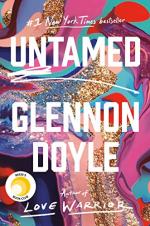|
This section contains 570 words (approx. 2 pages at 400 words per page) |

|
Untamed Summary & Study Guide Description
Untamed Summary & Study Guide includes comprehensive information and analysis to help you understand the book. This study guide contains the following sections:
This detailed literature summary also contains Topics for Discussion on Untamed by Glennon Doyle.
The following version of this book was used to create this study guide: Doyle, Glennon. Untamed. The Dial Press, 2020.
The book mixes first-person memoir with third-person analysis and commentary as the author explores what she learned about herself and about life in general after ending her marriage to engage in a love-relationship with another woman.
Throughout this analysis, the lower-case first letters of chapter titles reflect how those titles are presented throughout the book. Each chapter is written in past-tense narration, except where noted.
The book begins with a prologue in which the author describes a zoo-based encounter with a cheetah. Doyle comments that in spite of seeming to have had all the wildness tamed out of her, the cheetah was still able to respond to some kind of inner knowing of her nature. This image, of an inner wildness or untamed-ness existing even within circumstantial constriction, is a metaphoric foundation for the considerations and commentary that follow.
The main body of the book is divided into three parts, each with several chapters. The first part is titled “caged,” and explores the different ways that Doyle has come to understand she was restricted from being who she felt truly inclined to be. She references her struggles with eating disorders, psychiatric disorders, and addictions as different sorts of coping mechanisms to her experience of being “caged.” At Part One’s conclusion, she describes how an unplanned encounter with the woman that she eventually married seemed to open the doors to a number of cages, and allowed her to see possibilities for freedom.
The second part of the book is titled “Keys.” It consists of four chapters that Doyle suggests are the “keys” to women opening their own cages and letting themselves experience the truths of who they are, and of who they want to be.
The third part of the book is the longest of the three, and is titled “free.” In it, Doyle explores different ways in which she experienced freedom as a result of making the choices she did about leaving her marriage and starting a new life. Each chapter explores a different facet of the author’s emergence into a sense of personal freedom and empowerment, and how she began to feel driven to share her experiences of shaping her life with others. Key points of focus throughout this sequence of chapters are the author’s relationship with young people, her own children and those of others. Also, she continues to explore ways in which people in general and women in particular are put into cages that decide the nature of their lives for them. She also documents a range of triumphs, in both herself and in others, associated with experiences of people claiming themselves and their identities.
Also within part three, Doyle continues her examination of herself and her perspectives, exploring and commenting on ways in which she sees herself as having more to learn, more to understand, and more reasons to grow. She portrays herself as being in process, not having discovered all the answers as a result of leaving her marriage and changing her life but having found new ways to achieve answers, and bring them into the lives of others.
The book concludes with an epilogue in which Doyle offers a list of questions that she asks herself, and in doing so, suggests that readers ask those questions of themselves as well.
Read more from the Study Guide
|
This section contains 570 words (approx. 2 pages at 400 words per page) |

|



